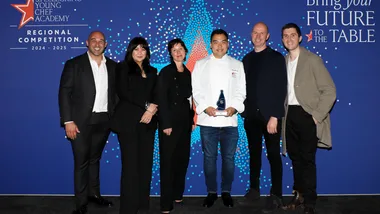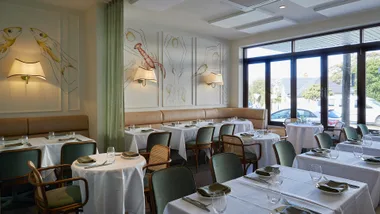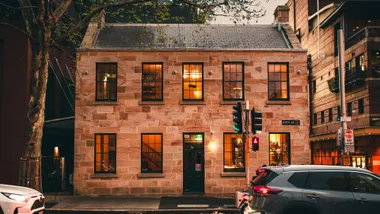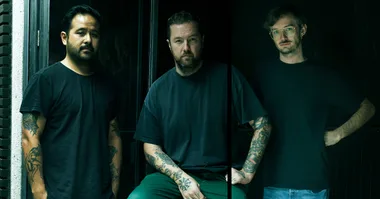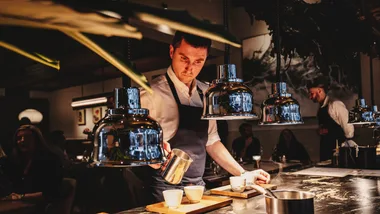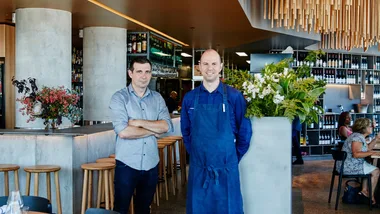It was the driest winter and hottest spring on record. Records continued to break with frightening regularity throughout a parched and horrible summer. The forest lost its misty-green lushness, mosses shrivelled and skinny wallabies came out to feed in daylight, so lean was the foraging.
Our farm was a dust bowl and, when my brewer friend Ashley called one day, all I heard was “beer?” Of course I said yes. What other answer is there to such a question in such a climate?
But after I hung up I began to think. Ashley doesn’t want to give me beer; although he’s a superbly hospitable man, he wants Tasmanian native herbs that I am somehow to find in a forest and garden that look like deserts.
I’d met Kylie Kwong and sommelier Giorgio De Maria through our friend Luke Burgess when he had his restaurant Garagistes in Hobart. I’d wandered my garden with both of them. Tasting plants with Kylie, hearing her unique thoughts was a rare treat, and Giorgio regaling us with stories of herbs from the Italian mountains for digestivo was inspiring. Little did I know the two of them would get talking, up in the big smoke, and hatch plans for future magic.
Last spring that magic became reality. I sent lush, Tasmanian native herbs to Two Metre Tall, Ashley and Jane Huntington’s on-farm brewery in Derwent Valley, and the first wild-fermented, Tasmanian-infused, Chinese food-matching ale was born: Farmhouse Ambigua #1. We drank, enjoying what fermentation and reactions with the beer did to our herbs. The brew was alive, and changed as it aged- some plants became more obvious, others faded, making for a dynamic brew that inspired thought, as well as quenching a good many thirsts.
As the barrels of Farmhouse Ambigua #1 at Billy Kwong began to run dry and Kylie asked Ashley if we could make another brew, I’d heard that wonderful word “beer” and agreed. And so it was that I found myself in that drought-ravaged forest, concerned with what flavours such sorry plants would yield. I filled my baskets and we drove to the farm where Ashley and Jane grow the grains for their beer, and where cattle graze, enjoying the spent grain. We took advantage of our delivery run and sat at the Farm Bar, tasting wild-fermented beers and ciders, grilling beer-fed steaks, and listening to Ashley’s stories.
I left my box of herbs wondering whether the dry weather would give a feeble infusion or concentrate the flavours and be overpowering? As I worried, I also felt gratitude. This dry season had been our worst. We’d noted the taste in our vegetables changing. Many failed, but others, such as the tomatoes, were rich and delicious. We all understand and accept the effects of seasons on wine, and these beers – one brew made in the fullness of spring, another in the midst of a drought – would be a way for us to see the season made flesh.
It was with a little trepidation, and with great appetite, that I ventured for my first visit to Billy Kwong to taste Farmhouse Ambigua #2 as it was meant to be, with Kylie’s food.
A glass was poured, and I was surprised at the colour – like a slightly cloudy blood-orange soda. Kylie poured herself a taste and we bent our heads in unison to sniff. The fruit soda impression remained, along with a gentle, yeasty, beery scent. Somehow, despite the absence of any fruit, except for a smattering of Tasmanian pepperberries, it almost felt as though I was drinking some sort of wine-beer hybrid, with the thick-textured satisfaction of something made with grain, but also the complexity and richness of flavour of wine.
I sat alone at the bar with a bowl of stir-fried native greens and another of red-braised Flinders Island wallaby tails in a state of bliss. Connections between our native flora and Chinese technique, ancient European brewing methods and a whole mess of intelligent, creative people had made something wonderful, and I’d been lucky enough to follow that path through a sad and crisp forest (since recovered, after a winter deluge, in case you were concerned) to a seat at a bar that felt more like a friend’s kitchen table.
-scaled.jpg?resize=720%2C405)
